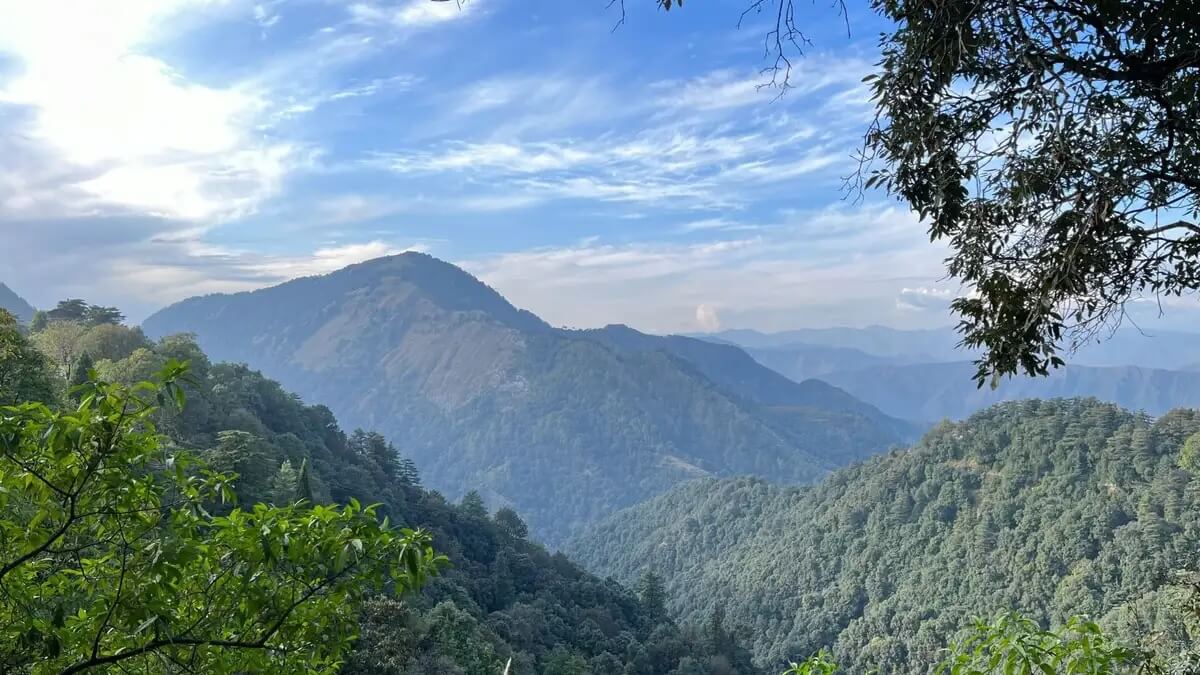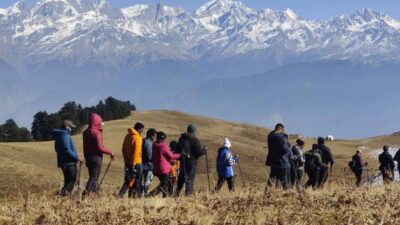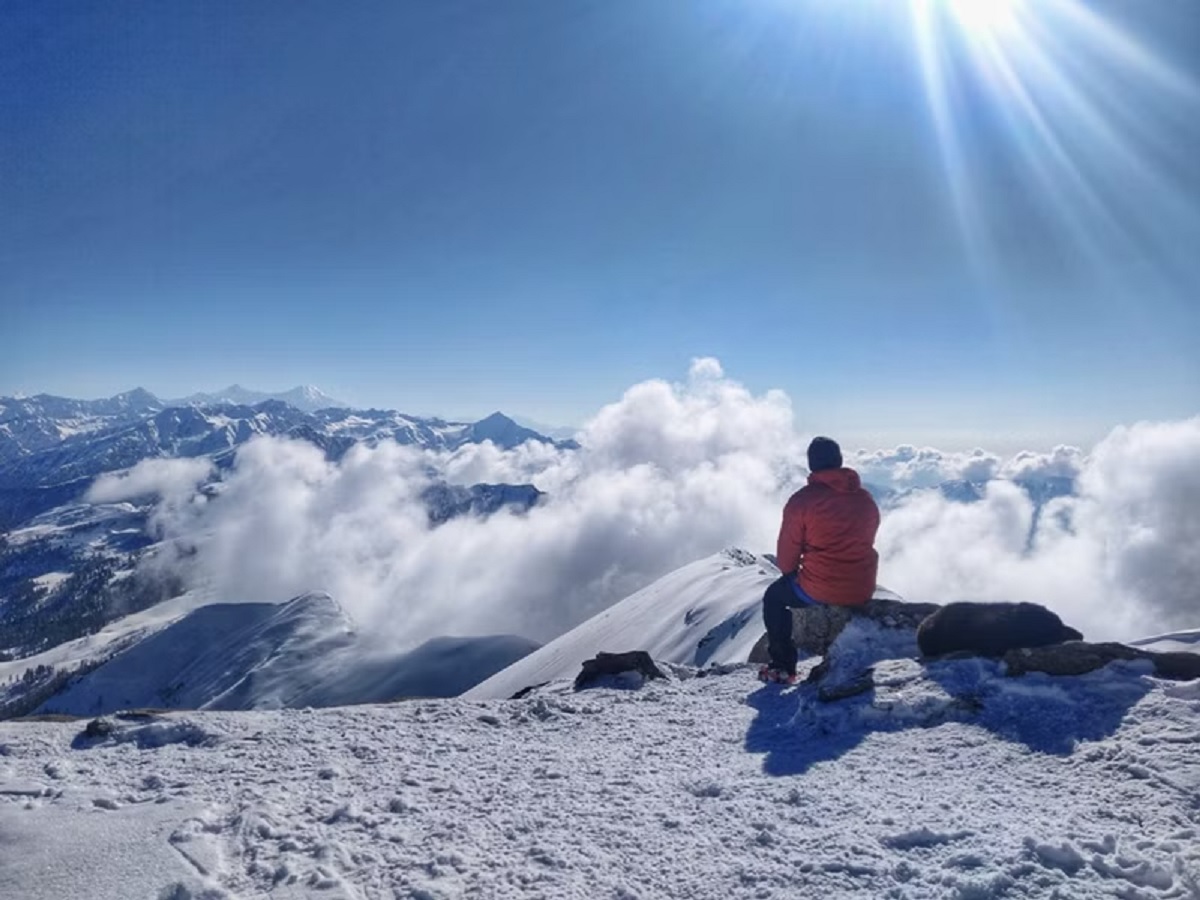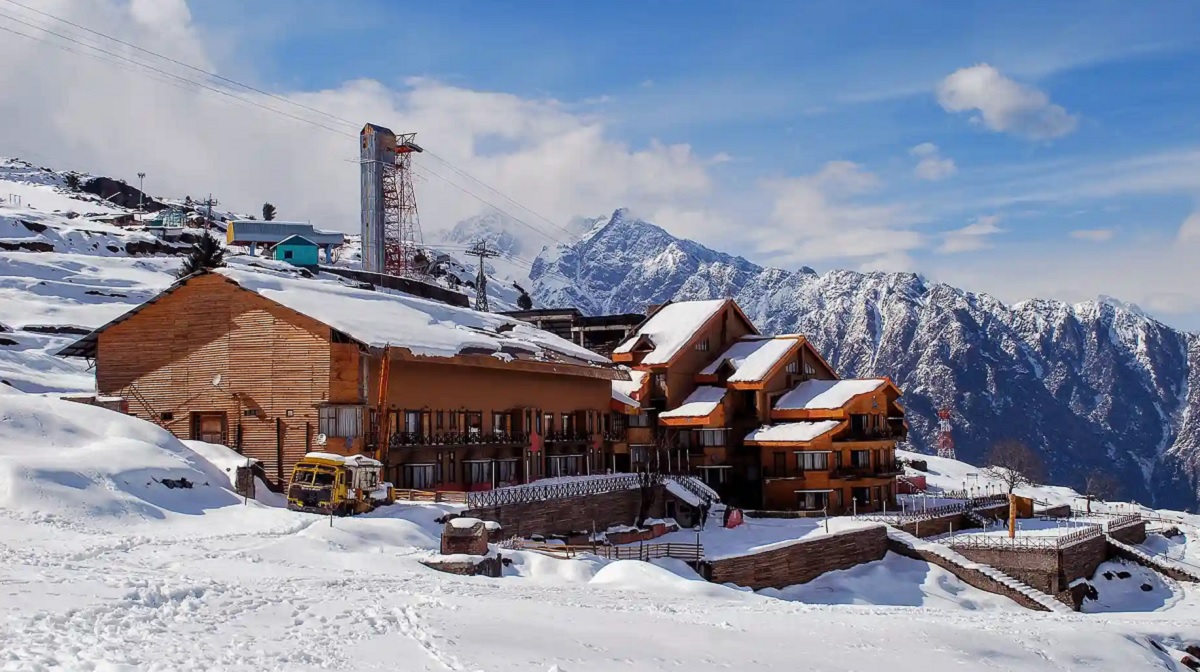Perched in the Garhwal Himalayas, Mussoorie has long been a jewel among India’s hill stations. Nicknamed the Queen of the Hills, this quaint colonial town has enchanted poets, writers, honeymooners, and nature lovers for over a century. Though Mussoorie is most visited in the summer for its cool climate and in winter for its snowfall, there’s something uniquely alluring about the monsoon season here that many travelers overlook.
From late June to early September, monsoon clouds sweep across the hills, bringing with them a hush of rain, the sweet smell of wet earth, and a serenity that’s rare in the modern world. Roads glisten with rain, pine trees drip with dew, and the mist curls around rooftops like an old fable come to life. With reduced foot traffic and lower tourist volumes, the town becomes a haven for peaceful reflection, romantic getaways, and soulful photography.
This comprehensive guide is for anyone curious about what Mussoorie offers during the rainy season. Whether you’re planning a honeymoon, a solo retreat, or a family vacation, we’ll explore everything you need to know—from weather conditions and best spots to visit, to food, safety tips, cultural nuances, and where to stay. Beyond just tourism, this article encourages a deeper connection to nature, to slower travel, and to the rejuvenating qualities of a simpler pace that monsoon travel demands.
So, let your umbrella be your travel companion, and prepare to walk through fog-laced streets, sip hot chai under tin roofs, and let the rain tell you stories only Mussoorie knows how to whisper.
The Enchantment of Monsoons in the Hills
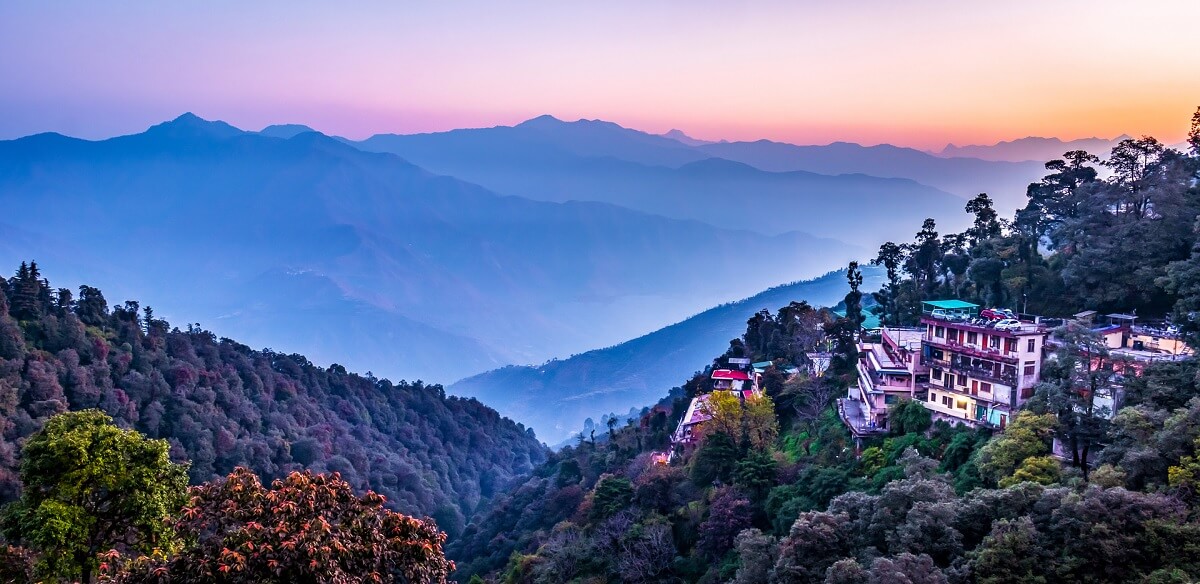
Monsoons in the mountains aren’t just a seasonal occurrence—they’re a sensory experience. The transformation begins as dark clouds loom over the Himalayan ridges, the temperature drops, and the first droplets fall, releasing the musky scent of petrichor—a fragrance that’s almost spiritual in its effect.
In Mussoorie, the monsoon adds layers of magic. The skies become a canvas of grey and white, pierced occasionally by bursts of light. The rain arrives in all moods—from soft drizzles that kiss your skin to torrential outbursts that send you scurrying for shelter under café canopies. But the showstopper is the mist—it floats like whispers through deodar forests, wraps itself around ancient colonial buildings, and swirls in the valleys like ghosts of old tales.
This weather is not just romantic; it’s deeply introspective. Many artists and writers, including Ruskin Bond, have taken inspiration from the melancholy beauty of Mussoorie’s monsoons. The slow rhythm of life during this season invites contemplation, reading, writing, or simply watching the rain fall while sipping on a hot cup of tea.
The flora too responds with a kind of celebration. Ferns unfurl, moss carpets the pathways, and tiny wildflowers bloom wherever there’s a gap in the stone walls or footpaths. Birds become more vocal between showers, and the play of light through the clouds gives photographers a feast of frames.
For travelers, the monsoon experience in Mussoorie is not about sightseeing in haste. It’s about immersing yourself in nature’s tempo. The rain becomes a muse, a balm, and sometimes even a challenge—but always, it transforms a simple trip into something soulful and unforgettable.
Why Visit Mussoorie During the Monsoon
Most tourists plan hill station trips in summer or winter, bypassing the monsoon due to fears of landslides, slippery roads, or travel disruption. But Mussoorie during the rainy season offers a secret window into a quieter, more intimate version of the town—one that locals cherish, and seasoned travelers return to again and again.
One of the most compelling reasons to visit is the absence of crowds. Unlike the peak season when Mall Road is jam-packed and viewpoints feel like a festival, the monsoon months offer breathing room. You can walk unhurried along scenic paths, explore heritage landmarks, or simply read by a foggy window, all without the rush.
Another advantage? Lower travel and accommodation costs. Hotels and guesthouses slash their rates by up to 40% in the off-season, making it ideal for those on a budget or for couples seeking a luxury experience at a fraction of the usual price. Restaurants and local shops are also more welcoming, with vendors having more time to chat and share stories.
The true highlight, though, is the scenic transformation. The rain breathes life into Mussoorie’s greenery—the trees shine with fresh sap, the hillsides erupt in lush grasses and moss, and the famous waterfalls like Kempty and Jharipani become ferocious, mesmerizing spectacles.
It’s also a perfect time for romance. Whether you’re newly married or rekindling old flames, there’s something inherently magical about strolling hand-in-hand through cloud-swathed roads, sharing a single umbrella, or watching the monsoon clouds roll over the Doon Valley from a cozy café.
Yes, the monsoon brings unpredictability, but it also brings poetry to life. If you’re willing to embrace its rhythm, Mussoorie will reward you with an experience no other season can offer—quiet, unfiltered beauty.
The Climate and Weather Patterns
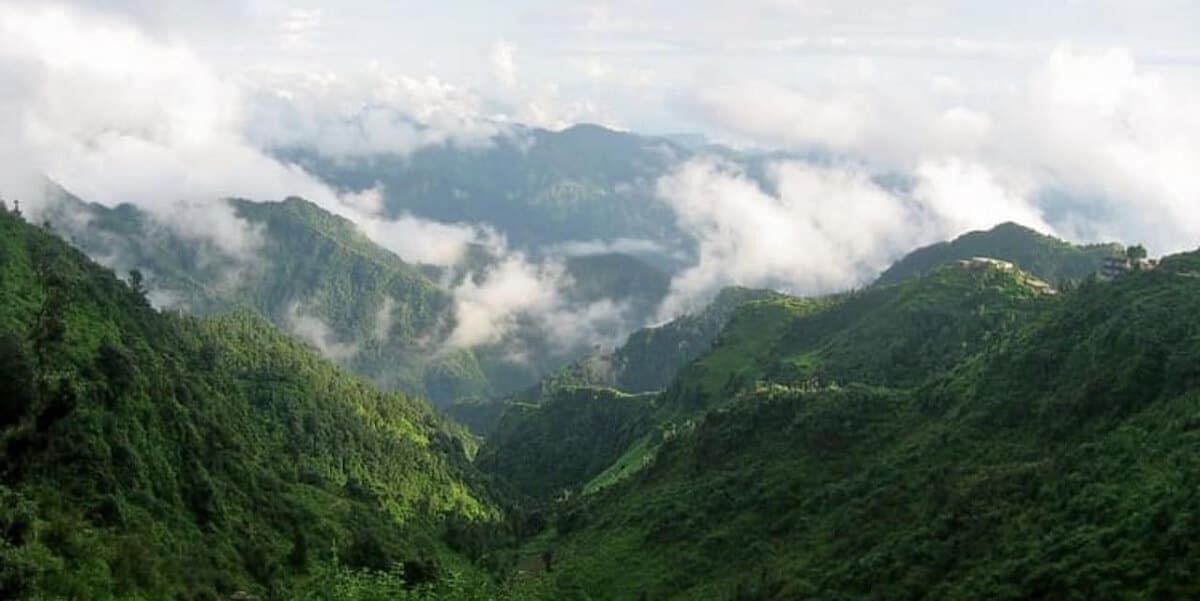
Understanding Mussoorie’s monsoon climate is crucial for planning a comfortable and safe trip. The rainy season here typically stretches from late June to early September, with July and August being the wettest months.
During this time, Mussoorie experiences frequent showers, often arriving in bursts rather than continuous downpour. Mornings may begin with clear skies or light mist, and by midday, clouds start gathering. Thunderstorms may follow in the late afternoon or evening, sometimes lasting through the night.
Here’s a quick look at weather stats during the monsoon:
Average Rainfall: 500–800 mm/month
Temperature: Ranges from 15°C (night) to 25°C (day)
Humidity: Stays around 80% to 90%, so expect damp clothes and sticky air at times
Visibility: Frequently obscured due to dense fog, especially on higher roads and trails
While this climate might seem challenging, it creates the perfect backdrop for slow travel. The mist and rain make everything appear dreamlike. However, you should also be aware of some potential concerns:
Road Conditions: While Mussoorie town roads are maintained, the approach roads from Dehradun can sometimes be blocked due to minor landslides. It’s wise to check weather alerts before your journey.
Power Cuts: Frequent in certain areas, especially during storms. Choose accommodations with backup generators.
Travel Gear: Carry light woolens, quick-dry clothing, waterproof jackets, and sturdy non-slip footwear.
That said, Mussoorie rarely experiences the kind of devastating landslides or floods seen in lower-altitude Himalayan towns. Thanks to its elevation and urban infrastructure, it remains comparatively safe and accessible, even during heavy rains. Planning your travel with flexibility and weather readiness is the key to a smooth trip.
A Walk Through the Rain-Kissed Landmarks
Monsoon turns Mussoorie’s familiar landmarks into dreamlike versions of themselves. The rain doesn’t just alter the landscape—it deepens its character, revealing textures and moods that dry days never show. Exploring these sites during the monsoon offers a more intimate and magical experience.
Mall Road
Mussoorie’s heart and soul, Mall Road, is a different experience in the rain. The streetlights reflect off the wet roads, turning the town into a shimmering tableau of color and shadow. Shops sell warm woolens, bookstores welcome browsers, and cafés become refuges. Grab a steaming cup of cocoa or masala chai, and watch the world dissolve into mist outside your window.
Camel’s Back Road
Named for the camel-shaped rock formation visible along the trail, this 3-kilometer stretch is especially enchanting in the monsoon. The walk is lined with pine and deodar trees dripping with dew. At certain bends, you’ll feel as if you’re walking through a tunnel of fog, with only the occasional raindrop tapping on your umbrella to break the silence.
Kempty Falls
Though often crowded in other seasons, Kempty Falls roars with life during the monsoon. The falls double in volume, tumbling dramatically over rocks and creating a thunderous white curtain of water. The area can get slippery, so exercise caution, but the sight is absolutely worth the short drive from town.
Gun Hill
Take the ropeway if weather permits, or trek up this short hill for a bird’s-eye view of the town. On clear days between showers, you’ll see clouds floating below your feet, and on foggy days, the surreal visibility makes it feel like you’re standing in the sky view in Gun Hill.
Every landmark becomes part of a slow-motion, rain-washed film, where the town’s colonial charm and Himalayan mystery blend in a rare union. Don’t rush—let the town reveal itself, one wet, glistening cobblestone at a time. Plan a 3-Day Mussoorie Escape – Limited Slots!
Nature at Its Most Vibrant
Monsoon is when Mother Nature takes the stage in Mussoorie. The entire ecosystem comes alive, from the tiniest insects to towering Himalayan oaks. While spring and summer offer bright blooms and sunshine, the monsoon season reveals the region’s lush, untamed beauty—greenery so intense it feels painted on.
The forest canopy glistens with dew and the moss-covered trails feel almost sacred. Pine and deodar trees drip with moisture, forming a natural cathedral under which birds sing and wind whispers. Ferns and creepers spread freely, reclaiming old walls and railings, turning even man-made structures into parts of the landscape.
Wildlife and Birdwatching
The monsoon air buzzes with life. You may spot Himalayan magpies, bulbuls, warblers, and the occasional mountain thrush flitting between the trees. After a shower, look down to see the flutter of butterflies along flower-strewn trails. If you’re lucky and quiet, you may even see shy mammals like barking deer or wild hares in forested areas near Benog Wildlife Sanctuary.
Flora Explosion
Wildflowers such as balsam, Himalayan blue poppy, and wild orchids begin to bloom in abundance. Lichens and moss grow thickly along tree trunks and rocks, providing rich textures for photography and painting. The abundance of water also brings out fungi, including bright orange and blue mushrooms—a delight for nature photographers.
Waterfalls and Streams
Seasonal waterfalls appear out of nowhere—small streams become brooks, brooks become rushing cascades. Besides the known falls like Bhatta Fall and Kempty, keep an eye out for hidden waterfalls along trails or behind lodges.
For lovers of the natural world, this is the time to pause and observe, to feel a deep connection to the living earth. Nature in Mussoorie isn’t just seen in the monsoon—it’s felt, from the damp earth beneath your feet to the vibrant canopy above. Book Your 4-Day Mussoorie & Dhanaulti Getaway Now
Monsoon Activities in Mussoorie

You might assume that rain would limit your options in Mussoorie—but the opposite is true. Monsoon opens up a host of unique and memorable activities, many of which are best experienced only during this season. While adventurous treks might be less advisable due to slippery paths, there are still plenty of rewarding ways to spend your time.
Nature Walks
Put on your raincoat and explore Mussoorie’s scenic trails. The Cloud’s End trail is a local favorite—a serene stretch that disappears into mist and ends at a charming colonial bungalow. Another great walk is the Landour Loop, which passes by old cemeteries, schools, and stone chapels—perfect for photographers and history lovers alike.
Spa and Wellness Experiences
Many high-end hotels like JW Marriott or Rokeby Manor offer Ayurvedic treatments and wellness therapies during the monsoon. The sound of rain combined with a deep tissue massage or steam bath creates a truly rejuvenating experience.
Bookshops and Literary Cafés
Mussoorie has a literary soul, thanks to authors like Ruskin Bond. Visit Cambridge Book Depot on Mall Road (he occasionally visits on Saturdays), or find your way to Café Ivy or Clocktower Café for hot coffee, fresh bakes, and an excellent selection of books.
Cooking Classes & Local Crafts
Join a Kumaoni cooking class or visit local craft stores that offer hands-on experiences with wood carving or wool weaving. These make for engaging indoor activities when it’s pouring outside.
Rainy-Day Picnics
Pack waterproof mats and a thermos of soup or chai, and head to Company Garden or a quiet forested area near George Everest’s House. Monsoon picnics are about savoring the mist, the smell of leaves, and the laughter of good company. Discover Why June 2025 Is a Great Time to Visit Uttarakhand
Culinary Delights During the Rainy Season
Rainy days in Mussoorie are best enjoyed with flavorful, hot food, and this charming hill town doesn’t disappoint. The monsoon season brings out the appetite for comfort dishes, especially those that warm you up after a wet walk or a misty trek.
Street Food Staples
Start with the basics. Nothing beats a plate of pakoras—crispy fritters made from onion, potato, or paneer—served with tangy chutney and a cup of masala chai from a roadside vendor. Mall Road and Library Chowk are full of stalls that offer these classics, especially in the evenings.
Steamed momos, a Tibetan dish that’s now a local favorite, are also a must-try. Served hot with spicy red chutney, they’re perfect for a quick, satisfying snack as the fog rolls in. Look for the small momo stalls near Kulri Bazaar or in Landour.
Café Culture
Mussoorie’s cafés come alive in monsoon. Head to Café Ivy in Landour for wood-fired pizzas and panoramic views, or try The Mudcup Café for a cozy nook, baked goods, and board games. These cafés often offer outdoor seating under canopies where you can sip honey-lemon tea while watching the drizzle.
Local Cuisine
For a taste of traditional Garhwali cuisine, visit Urban Turban Bistro or Domas Inn. Dishes like Aloo Ke Gutke (spiced potatoes), Mandua ki Roti (finger millet bread), and Jhangora Kheer (millet pudding) are both delicious and healthy. These warming meals pair beautifully with the weather.
Practical Tip
Bring a thermos to carry tea or soup while exploring. Also, try to eat fresh and hot food to avoid any health concerns that may arise during the humid season.
Rain or shine, Mussoorie’s food scene is rich, comforting, and full of character, perfectly suited to the pace and mood of the monsoon.
Travel Tips for Monsoon in Mussoorie
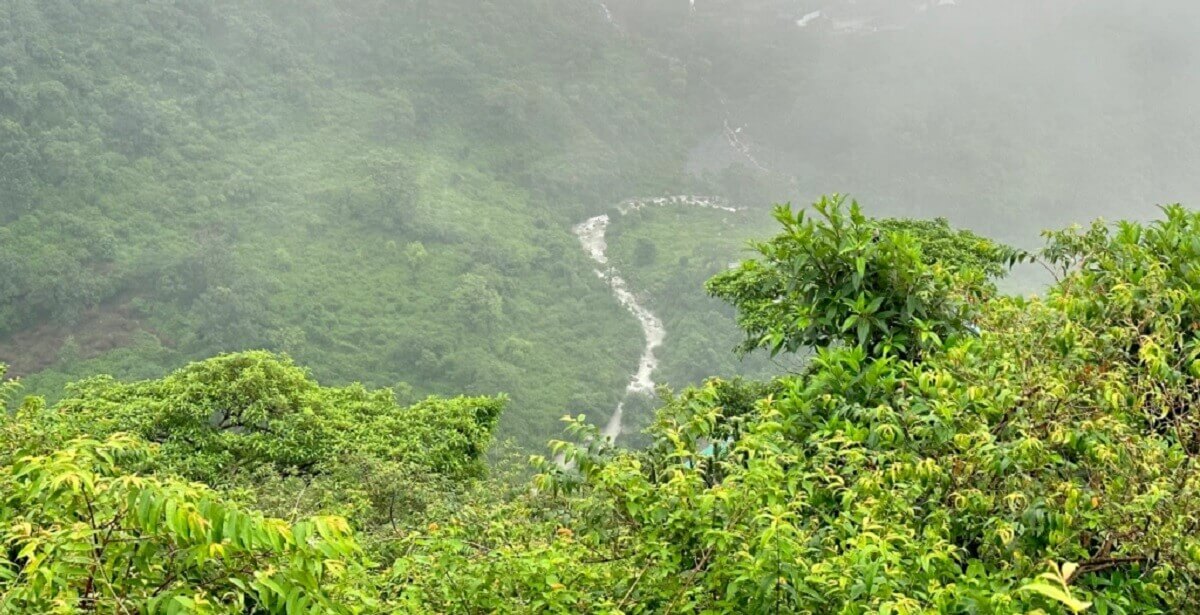
Visiting Mussoorie in the monsoon can be deeply rewarding, but it’s important to be prepared. With frequent rains, slick roads, and unpredictable weather, a few smart travel strategies can make your trip smoother and more enjoyable.
Pack Smart
You’ll need to be ready for changing conditions. Carry:
- A sturdy umbrella
- Lightweight waterproof jacket
- Quick-dry clothes
- Anti-slip shoes or sandals
Avoid heavy jeans or cottons that retain water. Opt for synthetic or moisture-wicking fabrics that dry quickly.
Protect Your Electronics
Pack your phones, cameras, and power banks in waterproof pouches or zip-lock bags. Keep chargers in sealed containers to avoid short circuits from damp conditions.
Stay Updated
Check weather apps like AccuWeather or IMD (India Meteorological Department) before planning daily outings. Rains in the hills can be sudden and heavy, so it’s better to schedule outdoor excursions in the morning and stay flexible.
Health Precautions
Carry a basic medical kit, including:
- Anti-nausea tablets
- Pain relievers
- Antibiotic cream for cuts
- Water purification tablets if you’re venturing into remote areas
Avoid eating raw food or drinking from unfiltered sources. Stick to boiled or bottled water, and eat at clean, reputable places.
Connectivity
Mobile networks like Jio and Airtel work well in town, but you may lose signal in higher or remote areas. Always download offline maps and keep important contacts saved.
Cash vs Card
While most of Mussoorie supports digital payments, power outages and patchy internet can hinder online transactions. Carry some cash for emergencies, especially if you plan to visit local markets or eat at smaller joints.
With these tips, you’ll not only stay safe—you’ll also be able to embrace the monsoon fully, rather than worrying about logistics. A little preparation goes a long way in making your trip magical. Plan Your Perfect Summer Getaway to Uttarakhand – Here’s How!
Safety and Accessibility
Monsoon brings undeniable beauty to Mussoorie, but it also demands extra awareness and caution. The landscape can shift quickly from peaceful to perilous if you’re not prepared. With a few safety considerations, you can ensure your visit remains enjoyable and incident-free.
Getting There Safely
Most visitors arrive via Dehradun, about 33 km away. Whether you’re traveling by taxi or private car, avoid night travel during heavy rains. Landslides, though infrequent in Mussoorie compared to other hill stations, can occur during persistent rainfall. Always check road conditions and local advisories before setting out.
Local Transport
Auto-rickshaws, taxis, and shared jeeps operate throughout the town. Avoid renting scooters during monsoon unless you’re an experienced hill driver, as roads can be slippery. Walking is often the best option—just be sure to wear non-slip shoes and carry a flashlight for evening strolls.
Staying Connected
Mussoorie town is relatively well-connected, with access to emergency services, hospitals, and police. Save these contacts in advance:
- Mussoorie Police Station: +91-135-2632101
- Sub-District Hospital: Landour, near Picture Palace
Where to Get Help
If weather conditions worsen, seek refuge in:
- Tourist Information Centers
- Major hotels or cafés (often with generators and emergency power)
Personal Safety Tips
Don’t hike alone during the rains.
Stay off steep trails or riverbeds when it’s raining.
Keep loved ones informed of your itinerary, especially if going off-grid.
Mussoorie remains a relatively safe and accessible hill station, even during monsoon. With common sense and local advice, you can navigate the season with ease and enjoy the quiet majesty that the rain brings to this mountain town. Top 9 Reasons to Visit Uttarakhand in 2025 – Don’t Miss Out!
Where to Stay: Cozy Accommodations with a View
Choosing the right place to stay during the monsoon can elevate your entire experience in Mussoorie. The rains bring an intimate, slow-paced mood, and the best accommodations take advantage of this by offering beautiful views, warm interiors, and a feeling of home away from home.
Colonial Charm
For those seeking historical ambiance, consider staying at Kasmanda Palace—a heritage property that dates back to the British Raj. Its vintage decor, wooden balconies, and panoramic views of the misty valley make it ideal for a monsoon retreat.
Another charming option is Rokeby Manor in Landour. This beautifully restored 19th-century estate blends rustic elegance with modern amenities. Surrounded by deodar forests and rolling fog, it’s perfect for couples or solo travelers who enjoy peace, books, and hot chocolate by the fireplace.
Budget & Mid-Range Comfort
If you’re on a moderate budget, Hotel Vishnu Palace and Hotel Brentwood offer clean, comfortable rooms with excellent monsoon views. They are centrally located and ideal for families or travelers looking to explore the main attractions without breaking the bank.
Homestays and Airbnb
Monsoon is a great time to choose homestays or Airbnb cottages. Many properties in Landour or near Barlowganj offer cozy hill-view rooms, kitchenettes, and the chance to interact with warm, welcoming hosts. These are excellent for longer stays, especially if you want to write, paint, or just unwind.
What to Look For
- Room heaters or electric blankets
- Large windows or balconies for rain-watching
- Reliable Wi-Fi (though prepare for occasional disruptions)
- Backup generators in case of power cuts
The key is to find a place that feels like a sanctuary from the storm—where you can sip tea, read a book, and listen to the rain tapping gently on the glass.
Local Culture and Festivals
While the rains slow things down in Mussoorie, the cultural heartbeat of the region continues to thrive. Experiencing the local festivals and customs during the monsoon gives your trip a meaningful, human connection beyond the scenery.
Seasonal Celebrations
One of the most beautiful monsoon festivals is Hariyali Devi, celebrated across Uttarakhand. This festival honors the goddess of greenery and fertility and takes place in late July or August. While the grandest celebrations occur in rural areas, you might witness smaller processions, folk songs, and temple offerings around Mussoorie.
In August, you’ll also find townsfolk preparing for Raksha Bandhan and Teej, festivals that emphasize family ties and feminine strength. Local women dress in vibrant green saris and gather in temples or homes, applying henna and singing traditional songs while swings are hung from trees—often visible in the gardens or backyards of homes.
Ruskin Bond’s Influence
Mussoorie has long been associated with literature, thanks largely to Ruskin Bond, who has lived here for decades. His stories often describe rainy hill-town days, and many locals take pride in his presence. You might even get to meet him at Cambridge Book Depot during one of his informal signing sessions (usually Saturdays at 3:30 PM, but call ahead to confirm).
Artistic Community
The monsoon is also a time when local artists, poets, and musicians retreat indoors and create. If you stay in Landour or attend a café open mic night, you might be lucky enough to hear live music, storytelling, or poetry inspired by the weather itself.
To truly understand Mussoorie during monsoon, engage with its people, stories, and traditions—they are the soul beneath the surface. Find the Best Time to Explore Uttarakhand With Your Family
Offbeat and Lesser-Known Experiences
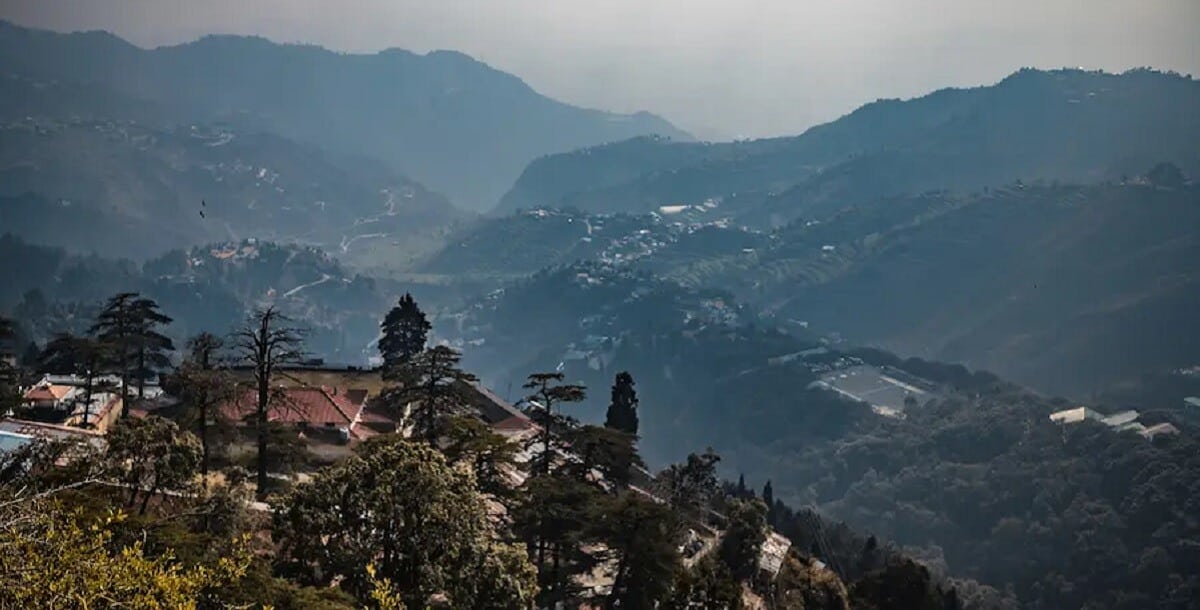
Want to escape the typical tourist circuit? Monsoon is the ideal time to explore Mussoorie’s hidden gems—places untouched by crowds where the only sounds are the patter of rain and your own footsteps.
Jabarkhet Nature Reserve
Just 15 minutes from Mussoorie, Jabarkhet Nature Reserve is a private forest sanctuary that offers eco-guided walks and wildlife tracking. The forest becomes a living tapestry of moss, ferns, and wildflowers during the rains. Expect to spot exotic birds, butterflies, and even porcupine tracks.
Happy Valley
Home to a large Tibetan community, Happy Valley offers serene monasteries, prayer flags, and sweeping views of the valley. Visit the Shedup Choepelling Temple—a vibrant, peaceful retreat surrounded by pine trees and often shrouded in mist. The monsoon adds a mystical quality to the experience.
George Everest’s House
While it’s gaining popularity, George Everest’s House remains quiet in the off-season. The short hike to the site is manageable even in light rain, and the reward is a breathtaking view of the Doon Valley and Himalayan peaks—when the clouds part. The colonial-era ruins have a haunted charm, made more poetic by the swirling fog.
Barlowganj and Clouds End
These lesser-visited areas are perfect for long walks and birdwatching. Clouds End, at the western edge of Mussoorie, is especially dramatic in the rains. You may find yourself walking through clouds themselves, with a deep sense of solitude.
Insider Tip
Ask locals for the way to Mossy Falls—a small, seasonal waterfall tucked into a forest glade. It’s not marked on every map but is one of the region’s best-kept secrets.
The monsoon gives you permission to slow down and wander without purpose. These offbeat experiences are not just escapes—they’re the heart of what makes Mussoorie special. Hidden Hill Stations in
A Photographer’s Paradise
If you’re a photography enthusiast, Mussoorie during the monsoon is an unmissable opportunity. The rains bring out a range of tones, moods, and textures that you won’t find in any other season. From low-hanging clouds to dew-laced leaves, every frame tells a quiet, poetic story.
Mist and Mood
The most iconic monsoon element in Mussoorie is mist. It rolls through valleys, wraps around trees, and occasionally hides entire buildings. This natural filter adds an ethereal quality to both landscape and portrait photography. Places like Camel’s Back Road and Cloud’s End are perfect for capturing foggy silhouettes and moody vistas.
Waterfall and Raindrop Photography
Waterfalls like Kempty Falls, Bhatta Falls, and the hidden Mossy Falls swell in volume and present excellent long-exposure opportunities. Even roadside streams become powerful subjects. Use a tripod and ND filter to capture silky water effects.
Raindrops clinging to leaves, windowpanes, or spiderwebs can create intimate macro shots. Keep a macro lens handy if you’re interested in close-up nature photography.
Colonial Charm
Mussoorie’s heritage architecture shines in the rain. Ivy-covered churches, stone pathways, and weathered houses look cinematic when wet. Walk around Landour for quaint corners with colonial windows and old lamps glowing softly through the mist.
People and Street Life
Locals wrapped in shawls, sipping chai at roadside stalls, children jumping over puddles—monsoon is also a great time for street photography. The subdued light and reflective surfaces create a natural contrast perfect for candid captures.
Practical Tips
- Carry a rain cover or waterproof pouch for your gear.
- Wipe lenses often to avoid moisture blurs.
- Use manual focus for foggy conditions.
Monsoon turns Mussoorie into a living canvas—subtle, emotional, and infinitely frame-worthy. Whether you use a DSLR or a smartphone, every click has the potential to become a story. How to Plan a Summer Trip to Uttarakhand
Environmental and Responsible Travel Tips
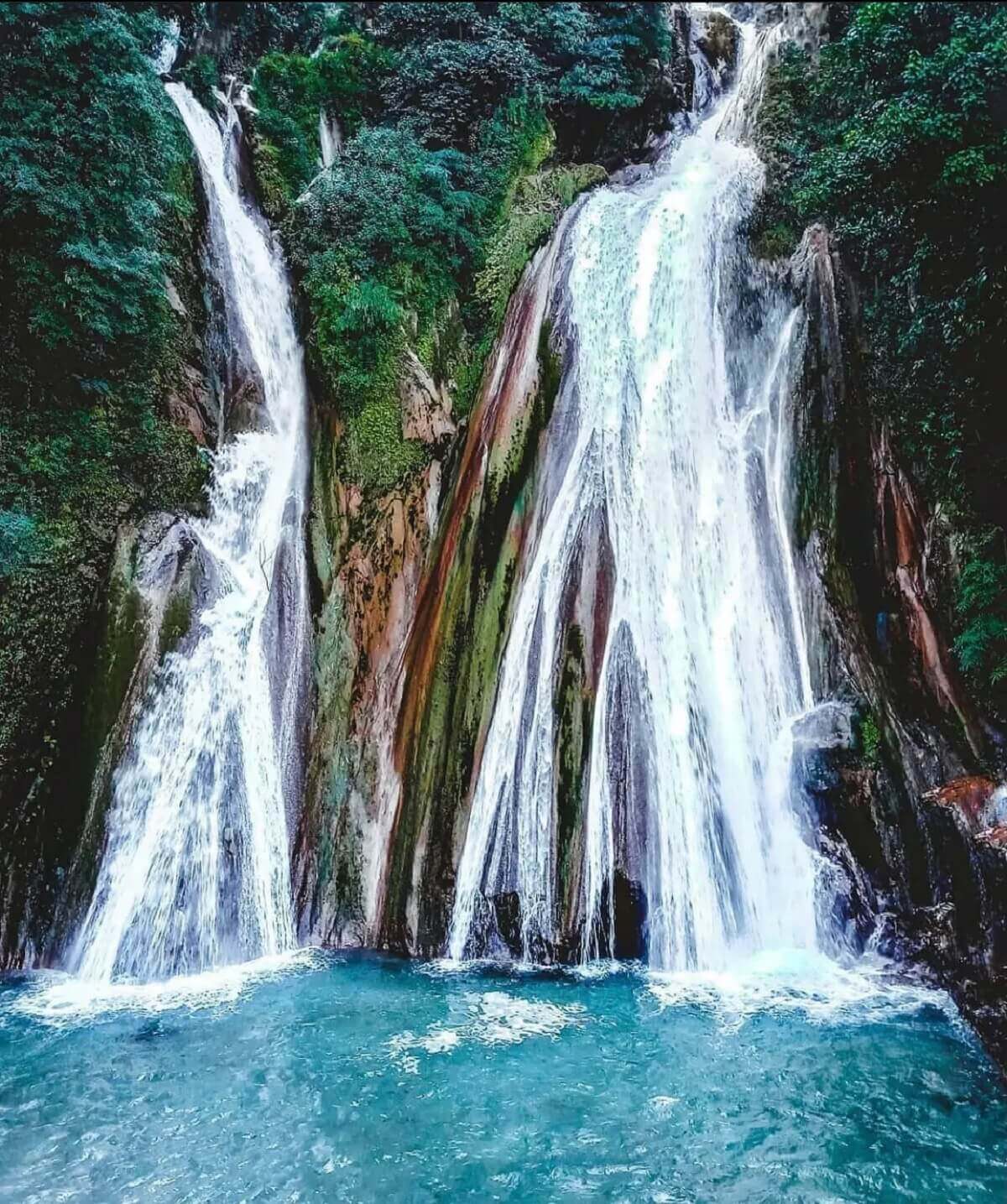
While the monsoon enhances the beauty of Mussoorie, it also stresses the environment, making responsible tourism more important than ever. Heavy rains can destabilize trails, pollute rivers, and strain local infrastructure. As a traveler, you can play a part in preserving this fragile ecosystem.
Avoid Plastic Waste
During the rains, discarded plastic can quickly clog drains and wash into rivers. Carry a reusable water bottle, metal straws, and cloth bags. Many cafés and hotels now offer refill stations—use them instead of buying packaged water.
Respect Trails and Wildlife
Stick to marked trails when hiking, especially in places like Jabarkhet Reserve or Benog Wildlife Sanctuary. Wandering off can damage plant life and disturb animal habitats, especially when the soil is soft and erosion-prone.
Avoid using loud music in open areas—it scares away wildlife and ruins the natural experience for others.
Support Local
Choose locally owned homestays, eat at small family-run eateries, and buy from local artisans. This not only boosts the local economy but also ensures your money supports the community directly.
Minimize Vehicle Use
Walk whenever possible. It’s safer during the rains, reduces your carbon footprint, and lets you enjoy Mussoorie’s monsoon ambiance more fully.
Be Informed
Stay updated on weather forecasts and local news. Sudden weather changes can lead to minor landslides or flooding. Know where to get help, and follow local advice about road conditions.
By traveling mindfully, you help ensure that Mussoorie’s natural and cultural beauty stays intact for future visitors—including your own return visit. Explore Top Summer Treks in Uttarakhand – Adventure Awaits!
Conclusion: Embrace the Monsoon Magic
Mussoorie in the monsoon is not about checking off a list of attractions—it’s about letting go of control and surrendering to the moment. The rain transforms this hill town into a place of poetry, nostalgia, and stillness, where every droplet tells a story, and every cloud that brushes past your window feels like a whispered promise.
Unlike the bustling summer months or the snowy peaks of winter, the monsoon invites you to slow down. It offers space for deep conversations, silent walks, spontaneous detours, and unplanned discoveries. Whether you’re watching mist settle over a tea estate or listening to the rhythmic patter on a tin roof, monsoon lets you experience Mussoorie with all your senses.
And yet, the beauty isn’t just in the scenery. It’s in the people, the quiet cafés, the old-school charm of bookshops, the smell of rain-soaked pine, and the simple joy of sharing an umbrella with someone you love.
For writers, thinkers, and dreamers, monsoon here feels like an invitation to create. For tired urban souls, it’s a chance to rest. And for wanderers, it’s a reminder that some journeys are meant to be felt, not rushed.
So pack your raincoat, open your heart to the hills, and let the monsoon in Mussoorie be a chapter in your own story.
Planning to explore more in the Place? Visit the full:
